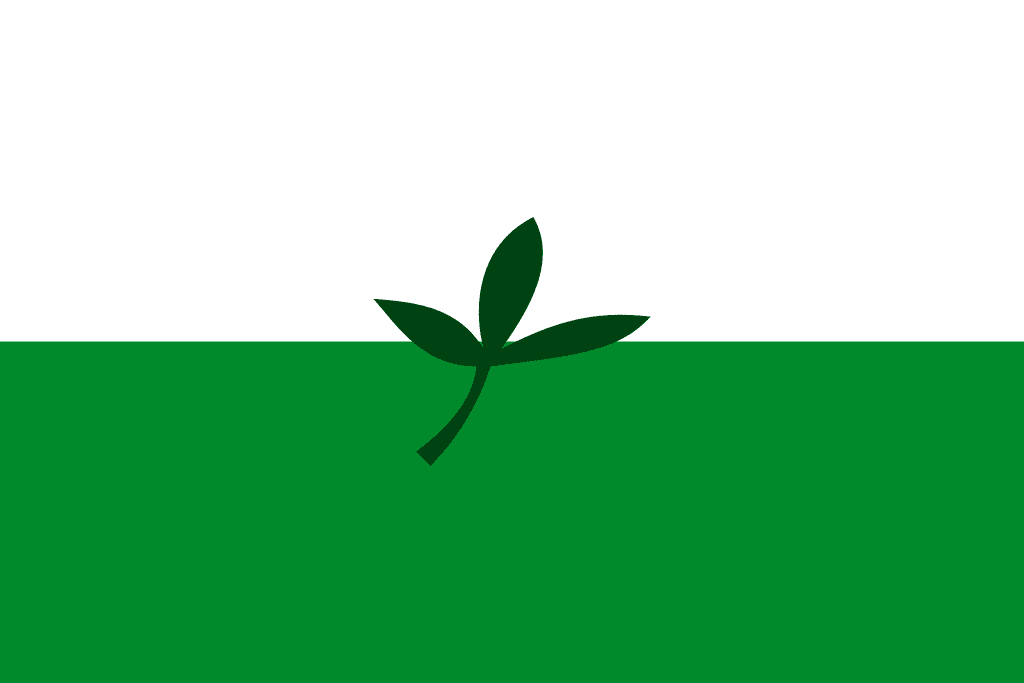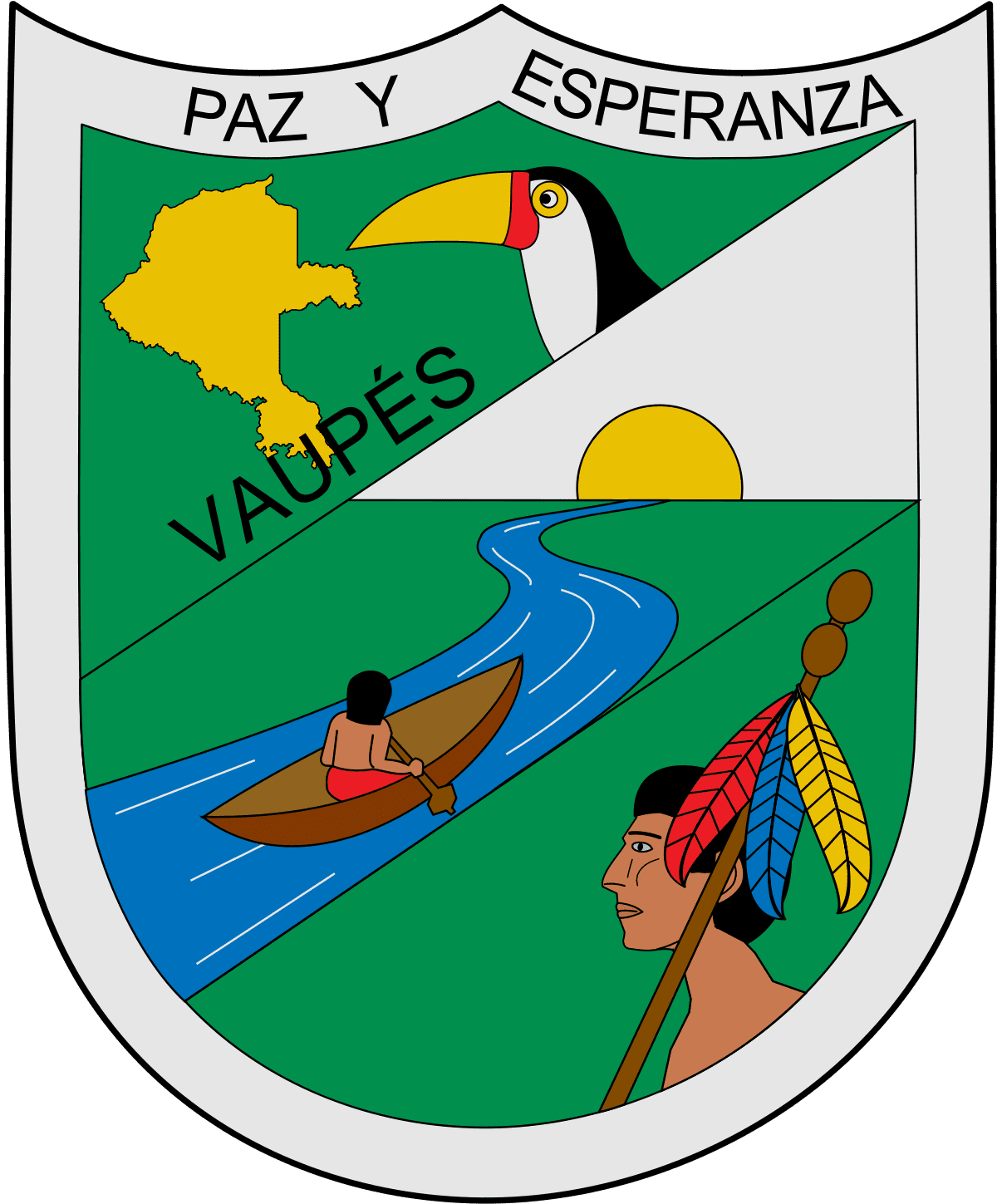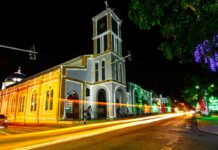Vaupes, It's one of the thirty-two departments that make up the Republic of Colombia. It is composed of 3 municipalities and 3 non-municipalized areas (previously known as departmental townships). Its capital is the municipality of Mitú.
Vaupés has immense water and jungle wealth; It is considered one of the departments that has best managed to protect its natural resources, this privileged abundance of nature represented in rivers, Amazon jungles, tepuis of the Guyanese coat of arms, waterfalls and rapids have made it a highly coveted tourist destination for lovers of nature and exploration.
The Department of Vaupés does not have land access roads due to its location in the Amazon jungle, its only access routes are by air or river; By 2023 it was the least populated department in Colombia, there are around 27 indigenous ethnic groups present in it, who have woven a rich culture and history in these jungle lands.
| VAUPÉS SYMBOLS |
Flag of Vaupés |
Shield of Vaupés |
| Click here to listen to: Vaupés Anthem |
| GENERAL DATA OF THE VAUPÉS |
| Country: Colombia. |
| Entity: Department. |
| Capital: Mitú |
| Demonym: Vaupense, Vaupesino, Vaupesina |
| Motto: Peace and hope |
| Foundation: December 15, 1910. |
| Erection as a department: July 4, 1991 |
| Number of Municipalities: 3 |
| Official Web site: vaupes.gov.co |
History of the Department of Vaupés:
In pre-Columbian times, the territory of the current department of Vaupés was home to various indigenous groups, such as the cubeos, desanos, guananos and tukanos, belonging to the linguistic group Tukano, which, thanks to their jungle habitat, managed to resist Westernization.
The first conquerors to arrive in the region were Hernán Pérez de Quesada in 1538 and Philip Von Hutten in 1541, when the area was part of the Popayan province.
A century later, Jesuit and Carmelite missions arrived from Brazil in 1657 and 1695, respectively. Starting in 1750, numerous missionary towns and Portuguese forts were founded that later disappeared. The government of The Great Colombia (1821-1830) assigned the territory to Boyacá department, and later became part of the Caquetá Territory until 1857. Then, in 1886, he joined the department of Cauca. Starting in 1880, Franciscan missions from Brazil began to penetrate the region, concentrating the indigenous people in villages, which caused indigenous revolts between 1910 and 1920.
During this period, the rubber exploitation It expanded, leading to the extinction of a large part of the indigenous population and marking the true conquest of the territory. In 1910, the Vaupés Police Station through decree 1131, separating it from the old territory of Caquetá. Between 1914 and 1917, Montfortian missionaries carried out several foundations in the territory, and from 1943, Protestant missions were established.
Between 1969 and 1970, with the support of missionaries, the indigenous resistance managed to expel the remnants of rubber exploitation. Before this, laws 18 of 1963 and 55 of 1977 segregated the Guaviare police stations and Guainía del Vaupés, shaping its current configuration as a police station.
Finally, in 1991, the Constitution elevated Vaupés to the category of department. Until 1936, the capital of Vaupés was Squid, which today is part of the department of Guaviare. However, the need to assert sovereignty on the border with Brazil led to the transfer of the capital to the newly created town of Mitú, located near the Vaupes River. In 1998, the FARC-EP carried out the Taking of Mitú, capital of the department, which was retaken by the Public Force in the Operation Angel Flight days after.
Political-administrative division of Vaupés
The Department of Vaupés is made up of 3 municipalities of which Mitú It is the capital and 3 non-municipalized areas (previously departmental townships). Below is the list of Municipalities and departmental districts of Vaupés.
| Municipalities and non-municipalized areas | Category |
|---|---|
| Mitú | Municipality (Capital) |
| Caruru | Municipality |
| Taraira | Municipality |
| Pacoa | Non-municipalized areas |
| Papunaua | Non-municipalized areas |
| Yavarate | Non-municipalized areas |
Gastronomy of Vaupés
The gastronomy of Vaupés is based on the food that the jungle and the rivers provide, with the exception of salt, which is imported from outside the department. Foods such as cassava brava, sweet cassava, corn, banana and yam are very present in its gastronomy because they are part of the agricultural activities in the area. Among the most emblematic dishes of Vaupés cuisine we find:
- The quiñapira
- The Casabe
- Limpet Meat
- The pilao de cerrillo
- The mojojoy
- The doll
- Manivar ants
- The wet fish
- The tapuro
- The pumpkin capon
- The farina
- Mingado
- Chive de patava
(See the complete list of Vaupés gastronomy recipes here)
Vaupés Fairs and Festivals
The festivities in Vaupés reflect the traditions of indigenous cultures and mestizajes. During the month of December, celebrations are held that include offerings, such as the “Fish Festival”, the “Fruit Festival” and the “Artisan Festival”. Likewise, in October, the “Colonial Integration Festival” is celebrated, an event that combines folklore and the delicious gastronomy of the region.
(See here the complete list of festivals, fairs, events and parties in Vaupés)
Vaupés Tourist Sites
Tourism has emerged as a sector with great potential in the department thanks to the natural wealth that the region enjoys and the great cultural heritage from the indigenous cultures that populate the area, who with their lifestyle and traditions attract attention. of visitors. Vaupés is one of the hidden gems of Colombia, perfect for all those who love nature and cultural tourism. Some of the most important tourist places in Vaupés are:
- The Jirijirimo Rapid
- Way Reariku Hill
- The hill of Urania
- The Cucura spout
(See the complete list of tourist places in Vaupés here)
Vaupés Economy
The economy of Vaupés is mainly focused on agriculture, with key crops such as cassava, sweet cassava, corn, banana, yam and various wild fruits. Inside, mining resources are used, such as gold. In addition, fishing and forestry play a fundamental role in the department's economy.
The artisanal production stands out for basket weaving, a skill practiced by the indigenous population and later marketed in Mitú and in the Monfort police inspection, in the Yavaraté district. In more recent times, tourism has been gaining relevance as a rising economic activity, taking advantage of the natural wealth of the region.
Legends and Myths of the Vaupés
The Department of Vaupés houses a rich collection of myths and legends that are closely intertwined with the cosmology of the indigenous ethnic groups of the region. Among the legends and myths that are part of the Vaupense imagination, the following stand out:
- The legend of the Morroco and the Danta
- Legend of the sun and his son
- The origin of the man
- Tuhixana's son
- The whites dominate the Indians
- The appearance of the sun, the wind and the seas
- Yepá punishes the animals
- Yepa leaves the earth
- The creation of the night
- The discovery of water and fish
- The discovery of the pig
- The daughter of the sun
- The snake and the mountain dog
These and other legends and myths form a vital part of the region's cultural heritage, transmitting wisdom, beliefs and teachings throughout generations in the Vaupés.







